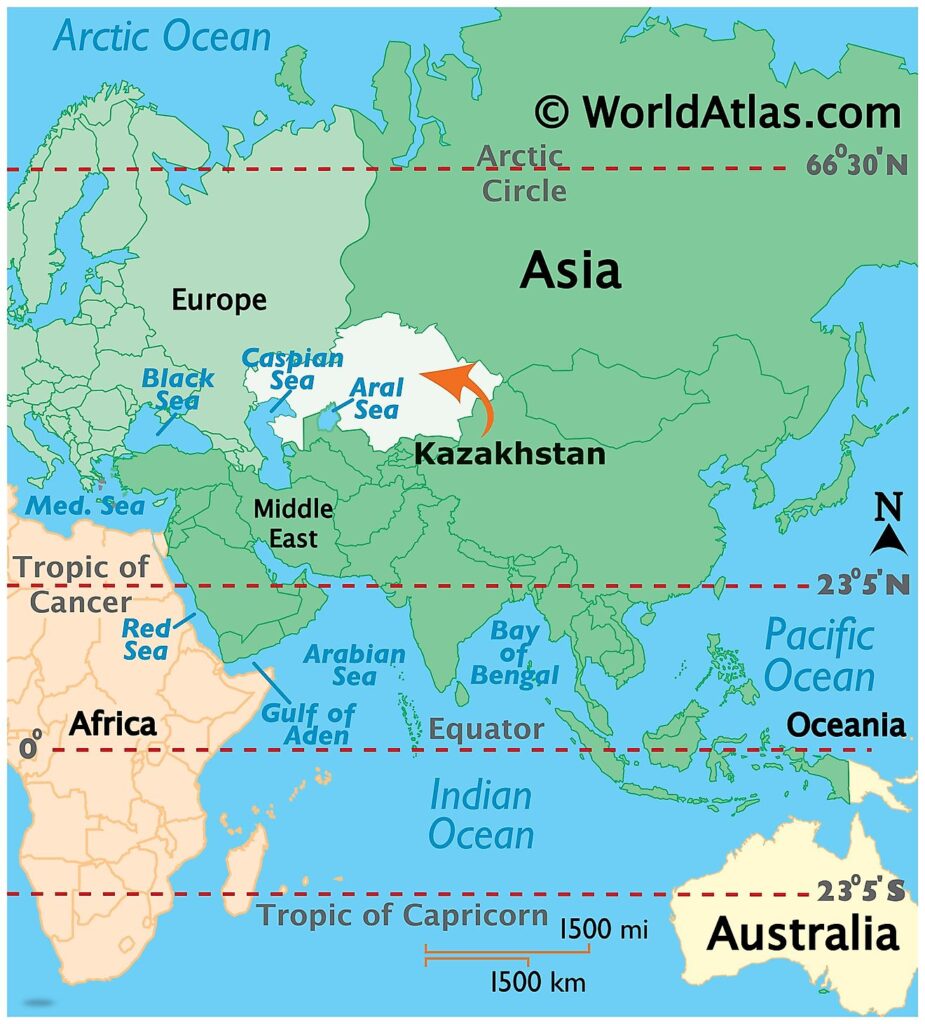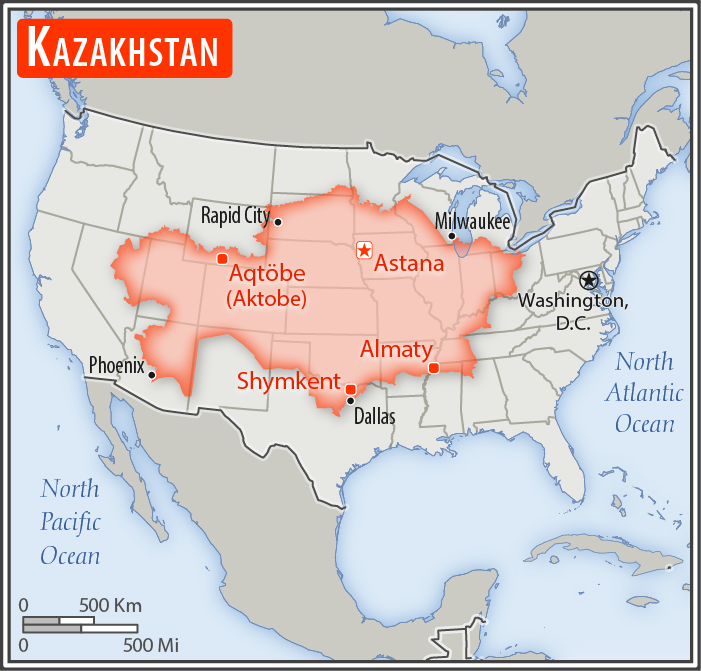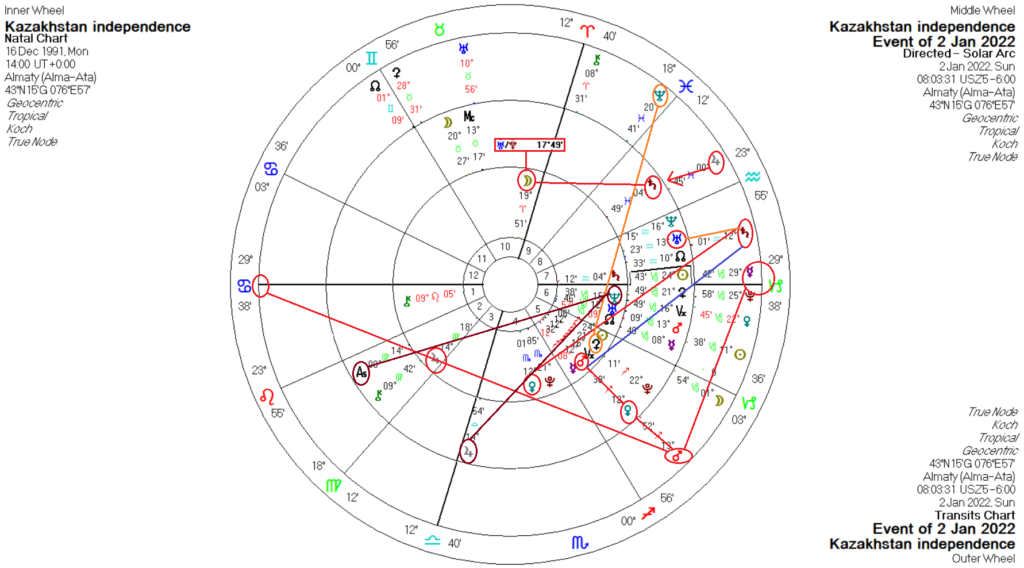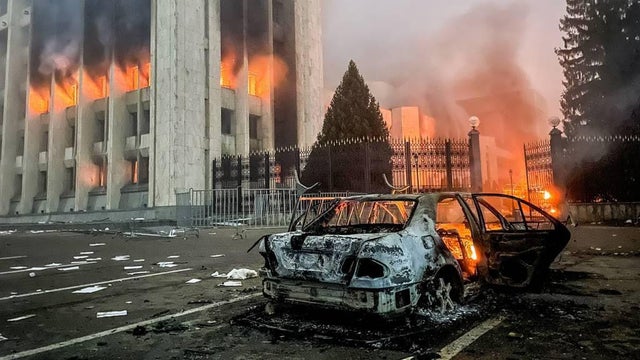Kazakhstan in recent days has been in the midst of the biggest protests and violence it has seen since its independence in 1991, leading a few comments to call what has happened, ‘Black January’. The present violence and protests allegedly began as a result of sharp increases in fuel prices. But as things progressed there it became clear that the protests began almost simultaneously across the country, strongly suggesting central organization, and Kazakh social media is awash with demands from the protesters, some of which also suggest foreign interference. This is a situation in development. We will begin to have a look at it here, to be updated as time goes on.
A little background on Kazakhstan will give us some context for what is going on there. Kazakhs declared their independence from the USSR on 16 Dec 1991. The time was listed by Russian astrologers as 14:00 UT, at Almaty. The chart is below (bigger):

Just very briefly, the main indicators in the chart are the Uranus/Meridian axis square, showing sudden turns in destiny and upsets, along with its multi-vector approach to relations with its neighbors (strong independence). The conjunction with Neptune shows as unusual inclinations and occasional lack of control, as well as a possible hidden or latent spiritual element or potential.
The nation’s great oil wealth is shown in the Jupiter/Neptune trine, while the square between Mars and Jupiter shows oligarchic control of that wealth as well as of the government. Mars rules the government of Kazakhstan. The Mars/Jupiter square also shows a tendency to risky behaviour – behaviour which has placed it in its present circumstances, with the inexperience of such a young nation showing in its choices in international relations. This will be parsed as we go along. Idealism, shown in the sextiles between Venus and Jupiter and Venus and Uranus, is now giving way to realities for the people of Kazakhstan. We will leave the astrology of the nation at that for now.
Kazakhstan is the world’s largest landlocked country and is the 9th-largest nation by landmass. It shares long borders with Russia and China. It borders the Caspian and Aral Seas and is therefore a close neighbour with Iran. Its western-most border is in the Caucasus region. Therein lies our first clues as to which foreign powers may be interested in Kazakhstan.

To give an idea of how big it is, Kazakhstan placed on the US is shown below:

To be as big as it is (3/8 the size of the contiguous US) its population is only just over 19 million, making it one of the most sparsely populated nations. About half of its populace is in its 10 major cities. The largest ethnic groups are Kazakhs and Russians, at 63% and 24%, roughly. There is also an ethnic Ukrainian group (2%) and Germans (1%). That demographic also gives us another clue about how the situation in Kazakhstan will resolve. Russia in particular has more than a little interest in the security of Kazakhstan as well for the ethnic Russians living there.
To round out the background on Kazakhstan before we get into what is taking place, there is the following:
“Kazakhstan is the most dominant nation of Central Asia economically and politically, generating 60% of the region’s GDP, primarily through its oil and gas industry. It also has vast mineral resources, and is officially a democratic, secular, unitary, constitutional republic with a diverse cultural heritage. Kazakhstan is a member of the United Nations (UN), WTO, CIS, the Shanghai Cooperation Organization (SCO), the Eurasian Economic Union, CSTO, OSCE, OIC, CCTS, and TURKSOY.”
The CSTO will become important, examined in a bit. The following breakdown gives us an idea of the chief resources in Kazakhstan:
What is not to like in terms of controlling Central Asia, if one can get the Kazakhs on-side? We should note, too, Kazakhstan is a main link in the Belt and Road Initiative:
With this background in mind we can begin to unpack what has just happened and why Kazakhstan figures strongly in the geopolitics of Asia and the Great Game between East and West.
Probably the most comprehensive analysis of what just took place in Kazakhstan comes from the site of Colonel Cassad. Unless you read Russian, use the machine translation. Beginning here, we have the following summary:
-
-
- Part of Kazakhstan is in Europe, and the Kazakhs have active interaction with the EU and the US, despite being neighbors with China and Russia. Their approach to international relations is ‘multi-vectored’, which can have several meanings. In this case, it has worked against western interests. The Kazakhs are also participating NATO partners. There are a number of Western NGOs active in Kazakhstan, as well as many Western corporations. USAID and the NED are both active there, for instance.
- There is rising wealth inequality in the nation, as well as rising tensions between the Russian minority and Kazakh nationalists, similar to what we see in Ukraine. This is fuelled by the NGOs. The goals of the NGOs are to create a ‘civil society’ (a kind of ‘third rail’ outside of government control and a destabilizing factor when ‘needed’) in Kazakhstan and to ‘democratize’ the nation, goals which they do not even hide.
- The rise in recent years of Turkish attempts (Turkey being a NATO member) to create a ‘Great Turan’ project and promote greater Turkistan tendencies. This also contributes to Islamic extremism and instability in the region. It encompasses all of the Central Asian ‘Stans, excluding Pakistan, large parts of Eastern Russia, and also extends into Xinjiang, China. This is a security concern for the Russian Federation as well as all of Asia.
- The protests took place in the context of rising tensions between the Russians and the US and occurred days before the meeting on 10 January between Russia and the US on Russian security concerns.
-
-
So, we pause here and see that, given the preceding points, it is easy to claim the violence we have just seen is a Western attempt at a color revolution in Kazakhstan. But it is more complicated than that. One of the largest problems now facing Kazakhstan is its desire to be able to interact equally with the West and the East, to be able to pick and choose and to sit on the fence when convenient. The problem in this century is that Washington increasingly mandates that nations ‘choose sides’ instead of each nation interacting on mutual desires and concerns. Kazakhstan is, in fact, a ‘bridging country’. But, given the tensions now between Russia and the US and the recent riots in Kazakhstan, the Kazakhs now find themselves in a difficult position if they try to continue along the multi-vector line. Continuing:
- There are several factions vying for power and influence in Kazakhstan. Firstly, the nation has been ruled by oligarchic factions since the nation’s independence, an oligarchy which arose in concert with the oligarchs across the old Soviet republics. Kazakhstan has yet to overcome that. Corruption and nepotism is rife. The nation was ruled by Nursultan Nazarbayev (for whom the capital was briefly renamed) for 28 years, with power passed to Kassym-Jomart Tokayev in 2019, the latter having close relations with Putin.
- There is a long history of British meddling in Central Asia via MI6 and British NGOs, which has intensified, with the aim of controlling trade routes and resources. It is an old imperial mind-set, but these agencies work hand-in-hand with Washington.
- Since the Western powers and the US in particular had to flee Afghanistan, there is now a power vacuum in that region along with a concerted effort by Western powers to retain a foothold in Central Asia. Kazakhstan is a prime and prized target in that regard.
- The Chinese want to see a stable and friendly Kazakhstan, as the nation is a key route in their Belt and Road initiative.
The trigger for the violence was the recent spike in fuel prices, which hit the average Kazakh hard. What started as peaceful protests were seconded by armed and violent factions within a day or two, and these arose almost simultaneously across the nation, suggesting central coordination. The demands by the peaceful protesters were initially reasonable. Then, within hours the demands turned political and the violence erupted. One of the demands was that Kazakhstan cut all alliances with Russia, another indicator of foreign interference, as Kazakhstan has traditionally had good relations with Russia. At that point the government was dismissed, Tokayev took control, Nazerbayev was side-lined to an extent (though he still wields considerable power in the nation) and Tokayev was faced with a very difficult situation, which resulted from the following:
“The United States has a developed infrastructure of “soft power” on the territory of Kazakhstan, and, importantly, in the second half of December, the US Embassy issued a warning about protests against Nazarbayev and Tokayev [what did they know beforehand?], which should be carried out by the “Democratic Choice of Kazakhstan” movement [reborn in 2017 after having been disbanded], which soon after the start of the protests in January puts forward demands for the resignation of Nazarbayev and Tokayev, deploying [issued from] a headquarters in Kiev [machine translate], from which he is trying to coordinate the protests. American satellites from Poland, Lithuania and Ukraine are joining the attempts to intercept the protest movement, from where local PSOs begin to work, inciting hatred within Kazakhstan and calling for pogroms and murders. Actually, an attempt is being made to direct the initial economic process into the channel of maximum violence along Ukrainian lines.”
What happened next sent a clear message to the US and NATO allies. Once the peaceful side of the protests had been seconded, there were an estimated 20,000 armed militants (the figure has since been revised downward a little) who took to the streets, took over government buildings, the national airport and generally ran amok, looting stores, killing police (even beheading some) and overwhelming the Kazakh security forces. There were reports of rioters breaking into the armory and taking away RPGs and anti-tank missiles – which civilians would not know how to use. There is a video of arms being delivered to rioters in a civilian vehicle, as well as reports of rioters using radios to coordinate groups. What was the origin of such arms? We can only guess.
And from where were the 20,000 (or 400 – 500) armed rioters/militants? That is not hard to guess. There are training camps for militants in Uzbekistan (start at 3:15), which was a springboard into Afghanistan and which happens to border Kazakhstan. These were easily moved across the porous border between Kyrgyystan, as well as being brought in over some months via a rat line from Syria, as in Idlib, and had set up sleeper cells in Kazakhstan.
Those militants were what prompted Tokayev to call on the CSTO for help. In a phone call to Putin, which lasted only 30 minutes, the CSTO was mobilized. 3,000 Spetsnaz special forces from Russia, 500 special forces from Belarus and smaller contingents from all the other CSTO members began to arrive in Kazakhstan. All the Russian forces were there in less than 24 hours. It is only a short hop from Russia to Kazakhstan in an Il-76 heavy airlift. There were an estimated 70 such planes, with Russian troops on the ground in 13 hours. At such short notice, though, it would appear the Russians were prepared for just such an event.
On 7 January Tokayev addressed the nation and called what was taking place under the CSTO banner an anti-terrorist operation. The CSTO forces are there for only a matter of weeks, to guard essential infrastructure and government buildings, while the indigenous security forces deal with the militants. In fact, those forces are already leaving, mission acconplished. Order has been almost wholly restored. There is a purge now taking place in Kazakhstan, and the head of the National Security Committee (KNB), Karim Massimov, has been arrested and charged with suspected high treason. He was an ally of Nazerbayev. There has been a wave of suicides among higher-ups in Kazakh police and national security forces since the plot has been revealed.
On another interesting twist, Massimov has ties to Hunter Biden, whom he calls a close friend. Also connected with Hunter is Kenes Rakishev, one of the richest oligarchs in Kazakhstan. Reading between the lines it would be difficult to believe Washington was not somehow involved in the current goings-on in Kazakh land. Hunter’s involvement there goes back to the Burisma deal in Ukraine, for which he is now infamous. Burisma had holdings in Kazakhstan.
On the whole, then, what we just witnessed in Kazakhstan was an attempted coup and color revolution, aided and abetted by outside forces (probably the usual suspects) and factions within the government. The entire situation is quite complicated, with many different actors, but this gives us the gist. However, denying it was a color revolution, the head of the State Council recently reported the acts were “A conspiracy of internal and external forces”. But that is usually what color revolutions entail. The timing of the events there has not gone unnoticed. But the attempt has failed, witnessed by the grumpy reports coming out of Washington and Ankara.
Finally, regarding the CSTO mission, the head of the State Council also added:
“1. The CSTO mission in Kazakhstan will not last long, and after solving all the tasks to stabilize the situation, the peacekeepers will be withdrawn from the country.
-
- The main task of the peacekeepers will be the protection of strategic objects, which will allow the Kazakh security forces to carry out the tasks of the CTO.
- Kazakhstan faced a carefully planned and sudden attack by a whole army of radicals in different regions of the country. They were associated with the complete destabilization of the country.
- The Kazakh special forces “Arystan”, “Arlan”, “Berket”, as well as the troops of the Ministry of Defense of Kazakhstan, are engaged in direct cleansing of the militants.”
-
So, we watch this space, but we can probably expect this to pass from the news cycle in the West pretty quickly. It has already fallen way down in the top stories, at least on CNN. American media does not like reporting on establishment failures. The astrology for the nation confirms the outcome and the short duration of the operations there. The chart with directions and transits is below (bigger):
-

In situations like the militant action in Kazakhstan we look first to Mars and then to the MC and the ruler of the MC. If there is indeed a revolution then some combination of Uranus and Pluto together would be prominent. We do not see that here. The MC is not activated. However, the ruler of the MC (Mars) was activated, but by Venus and a transit of Mars (Mars return).
The natal Uranus/Pluto (revolution) midpoint is not active. But the directed midpoint is two degrees away from the Kazakh Moon, which rules the 1st house (the people). If we find directions of that midpoint 2 – 3 degrees from a planet or angle, then we know some sort of radical change is taking place. That is the case here, but it involves the people of Kazakhstan and the internal affairs of the nation rather than the government.
When the protests started, on the 2nd of January, transiting Mars sesquisquared the Ascendant, had just completed the Mars return and had activated the direction of Venus to Mars. Transiting Mercury was on the Descendant on the day, marking the protests (peaceful at that time) and with transiting Saturn sextile natal Mars. With such a stabilizing factor the government was going to survive, barring adverse directions to Mars and/or the MC, of which there were none.
Of interest is the involvement of Neptune in the chart. Transiting Neptune squared the nata Ceres, marking a kind of turning point. But the direction it would take was cloudy or unclear. Transiting Neptune was in the 9th house, showing the foreign involvement and the clandestine nature of the militancy.
The pain of the events and the destruction of infrastructure was shown by transiting Saturn in exact square to natal Venus, the latter ruling the 4th house (infrastructure), but also showing the failure of the opposition to achieve their goals. The 4th house shows the parties in opposition to the sitting government.
The directed Ascendant and directed Jupiter form a combination with the natal Neptune, Jupiter/Ascendant=Neptune: “The tendency to live in hopes or expectations together with others, hoping for personal luck, the inclination to speculate. – Unfulfilled hopes, disappointments, losses.” Of particular note is the combination of Jupiter and the Ascendant, semisquare in the independence chart, which points to wealthy people in the society. The direction to natal Neptune, the latter ruling the 9th house, showed the influence of foreign actors on wealthy factions in Kazakh society.
Although the chart has not been confirmed as being wholly accurate, in this particular instance it appears to describe events fairly well.
In summary, what all this means for Kazakhstan for the future brings in some interesting speculation. With purges taking place there now, and if Western involvement is found to be true (which it has been), then the Western NGOs may be forced to leave Kazakhstan, and the Western powers would lose yet another foothold in Central Asia, and one of the most valuable. It has already made the Russian position in the region that much stronger. To be certain, Kazakh society will be changing over the next couple of years, in holding with the timing of the Uranus/Pluto midpoint. There will also be a transit of Pluto across the Descendant over that period, too. We will watch those changes with interest.
This episode has been good for Russia, too, in that the CSTO has been shown to be quite effective. Blinken’s statement to the effect that once Russians are in a country it is hard to get them to leave is just so much hypocrisy and sour grapes, considering the number of foreign US military bases around the world since WWII. And the Kazakh’s ‘Black January’ will in no way affect the talks between Russia, the US and NATO. But that is another story.
In all, Kazakhstan’s Black January will quickly fade to memory, and it will serve to strengthen the CSTO. Eyes will turn to Uzbekistan now, which was once a CSTO member. Azerbaijan, Uzbekistan and Georgia may be re-thinking their withdrawal from the CSTO, givem what has jast taken place. But any bases being used in Uzbekistan to train militants will probably soon be dismantled, especially since the West has vacated Afghanistan militarily. This episode has been yet another example of Western meddling in another state’s affairs backfiring and producing the opposite of the desired outcome for the West. Central Asia has just been further integrated into the BRI and Greater Eurasia project.
-
For further information on what has happened and the possible ramifications, watch Pepe Escobar’s analysis on The Grayzone for details.
-
Featured pic from Reddit

